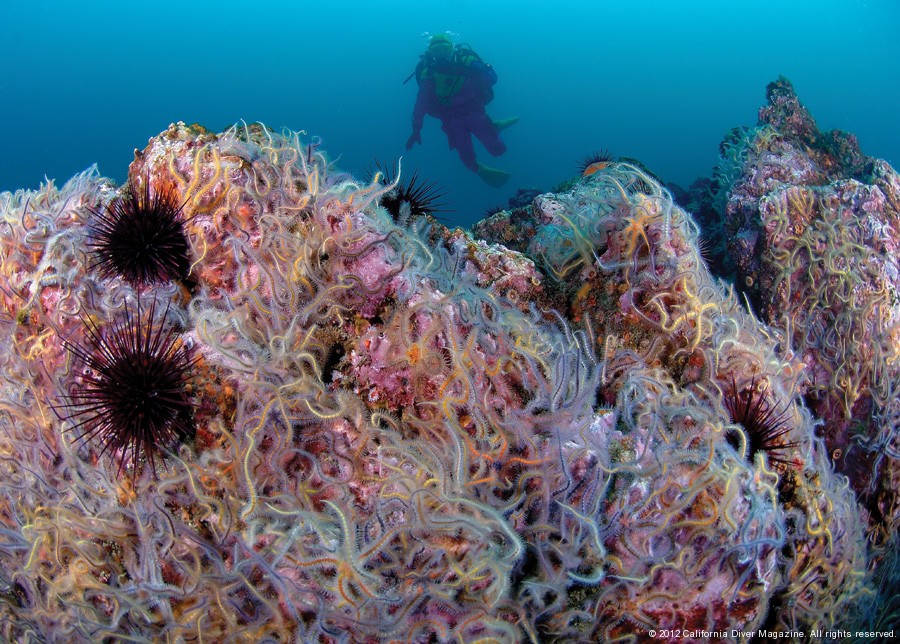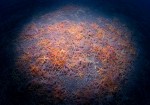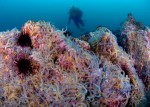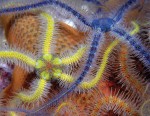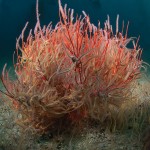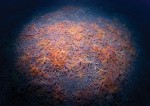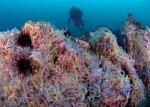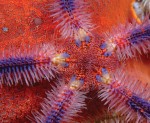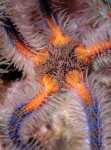They came from the murky, black depths. Just a few at first, followed by tens of millions. Their snake-like arms moved along the dark, sandy bottom toward the unsuspecting sunlit shallows above. It was a silent invasion. Without a sound, the creatures completely took over.
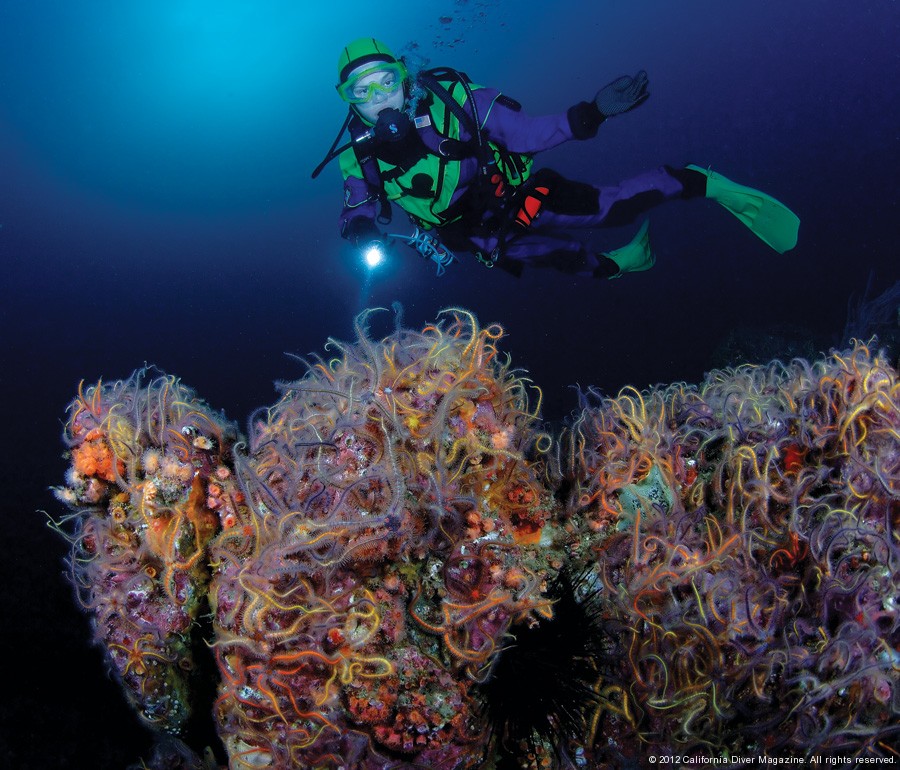 (Click on each photo to see the full size image)
(Click on each photo to see the full size image)
This may sound like a plot from a low budget sci-fi film, but it’s actually a (highly dramatized) description of what is happening around Anacapa, one of the Channel Islands. The deadly invaders are brittle stars, also called serpent stars, and the drama has been occurring since the early 1990s. Today, the brittle star fields of Anacapa cover a huge proportion of the sub-tidal depths (generally between 30 and 140 feet). Their numbers are so great that only a few other bottom-living life forms—such as algae gametophytes (baby kelp plants)—can survive long enough to get established over the voracious living carpet. In a relatively short period, the brittle stars have changed vast areas of the island’s ecology dramatically.
—————————————————————————-
Story by Joseph C. Dovala, photos by Dovala images
—————————————————————————-
Most California divers have seen brittle stars on their cold-water forays. However, these critters are not always readily identifiable, since their lifestyle can make them difficult to find. Brittle stars are not sea stars or starfish. Their body shape, feeding habits, and means of locomotion are all quite different from these other species. In fact, brittle stars are in a class within the phylum Echinodermata called Ophiuroidea, meaning “snake-tail form.” Unlike sea stars, brittle stars have very few suckers on their arms (called rays). They move with a writhing, serpent-like motion across the sea floor. The many small spines on their rays help to anchor them in the substrate, which allows the body, or central disk, to be pulled rapidly forward. This method of locomotion makes it look like they are leaping across the bottom. They are considerably faster than sea stars.
Escape artists
Brittle stars can also easily shed a ray, if necessary—similar to a lizard leaving his tail behind. This is a defense against predators, who may grab one limb, only to have it left wiggling in its grasp. While the attacker’s attention is riveted on the severed appendage, the brittle star makes an escape. The brittle star regenerates these lost limbs rapidly.
Also in contrast to sea stars, brittle stars have no vital organs extending into their rays. They cannot, as sea stars do, evert their stomachs for “external” feeding. Besides scavenging on the ocean floor for organic material, they are able to extend their rays up into the water column to capture drifting plankton. The effect is something like the appearance of enthusiastic concert fans waving their arms in the air. Because their bodies are often completely buried under the sand while their long, undulating rays wave in the surge, they have a worm-like appearance.
Masters of disguise
Much of the brittle star’s existence is spent hiding in crevices and under objects, away from direct light and predators. They do most of their foraging at night. They occupy nearly every marine environment—from tide pools to abyssal plains miles below the ocean’s surface. The largest, most dense populations of brittle stars reside in the dark depths of the continental shelf.
Not only are there more species of brittle stars than sea stars, their total population is also many times larger. What prompted the mass migration into shallower waters? Why has nature not restored balance to Anacapa Island’s temperate reefs? According to chief marine biologist Gary Davis of the National Park Service, the populations of larger predators are so diminished from overfishing that they can no longer keep up with the burgeoning brittle star population. Rockfish, sheephead, and large lobsters savor the spiny-skinned brittle stars. However, if the majority of these hunters end up on our dinner plates, their quarry can run amuck.
In 1995, commercial fisheries removed over 250,000 pounds of sheephead and 620,000 pounds of lobster—off the coast of Southern California alone. And these numbers do not include the sport-fishing catch. Rockfish harvesting has been so excessive (nearly 1,000,000 pounds in 1995) that both recreational and commercial rockfish harvesting was closed in 2003. All three of these species have natural life spans of fifty-plus years, and take many years to reach breeding age. So rebuilding the brittle stars’ predator population could take a long time.
At least for now, it seems as though the brittle star fields of Anacapa are here to stay. Their numbers are staggering, and their colors brilliant and varied. Like snowflakes, no two are the same—a kaleidoscope of color and form.
No one knows for sure how long brittle stars can survive in the wild, but some species live as long as fifteen years in captivity. They rely on two forms of reproduction— broadcast spawning and brooding. With broadcast spawning, a brittle just ejects gametes into the water, relying on chance collisions of egg and sperm for fertilization. With brooding, fertilization occurs within the brittle star’s central disk. Larvae forms inside the animal and is released into the sea. With two breeding options and being opportunistic feeders, the brittle stars seem to have the population cards stacked in their favor.
Tenacious tenants
Some divers who visit the brittle-star fields around Anacapa Island consider them wastelands. And there is no denying that the incursion has had a tremendous negative impact on the kelp ecosystem. Unfortunately, until humans limit their interference with the ocean’s ecosystem, divers can do nothing more than make the best of the changes.
As for me, I’ve been spending time getting to know these creatures, and my fascination grows with each encounter. To my camera’s lens, they provide almost limitless creative opportunities. Perhaps you’ll feel the same.



